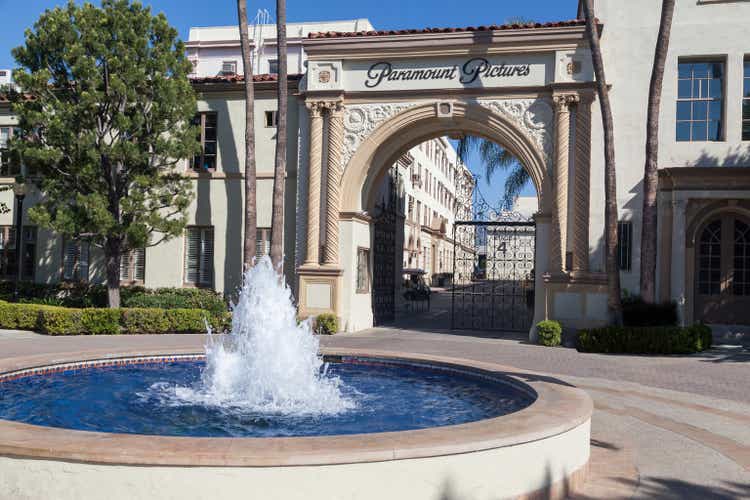Editor’s note: Seeking Alpha is proud to welcome International Investor as a new contributing analyst. You can become one too! Share your best investment idea by submitting your article for review to our editors. Get published, earn money, and unlock exclusive SA Premium access. Click here to find out more »
AlexandreFagundes
At the moment, I believe Paramount Global (NASDAQ:PARA) shares (which are the Class B shares) are far depressed compared to the underlying value of all the company’s assets. A non-binding offer by Sony and Apollo Global could lead to a deal taking the company private at $22 or more per share, rewarding new investors in PARA with massive gains compared to the current stock price of $12-$13. Existing investors who bought above $20 may or may not be rewarded, depending on the details of the Sony-Apollo offer. Longer out-of-the-money call options might win big if the Sony-Apollo deal proceeds at $22 per share or more.
In this article, I will try to explain why I think Sony-Apollo will offer more than most investors expect and why the PARA shares are far undervalued compared to the Paramount Global (NASDAQ:PARAA), or the Class A, shares.
A fair warning, though: investing in Paramount is not for everyone. One could make a corporate drama movie about what happened with the stock. In the last few weeks alone, we had Warren Buffett selling his PARA shares at a massive loss and publicly talking about it at the Berkshire (BRK.A) (BRK.B) annual shareholder meeting, “We lost quite a bit of money”
Meanwhile, we have the trial of Bill Hwang running in the background, who blew up his hedge fund Archegos while investing in shares of ViacomCBS (now Paramount Global).
Earlier Offers from Skydance and Apollo
Then we have Skydance led by David Ellison (son of Larry Ellison) vying to buy the controlling stake held by heiress Shari Redstone in Paramount Global via her investment vehicle National Amusements (NAI). To me, this appears more of a take-under kind of deal that would seriously dilute the value of PARA shares. National Amusements, the Redstone family company, needs to repay debts. Shari Redstone has already sold some real estate and is looking for cash to pay these NAI debts. The greatest asset of NAI is the 77% of voting rights of PARAA. These shares give Redstone control over all important decisions relating to Paramount Global.
When Apollo Global Management (APO) showed up to make a $27 billion cash bid based on the Enterprise Value of Paramount on April 3, 2024, other Paramount shareholders found out that Skydance was also interested in Paramount and that there were exclusive negotiations going on. Skydance tried to structure a buyout of NAI in order to gain control over Paramount Global by overpaying for PARAA and diluting PARA holders, who own about 90% of the economic value of the company.
This move caused a lot of public backlash from large PARA investors such as Ariel Investments. The threat of serious litigation probably made the decision makers at the board and the special committee of Paramount wary of the Skydance deal. In an April 2024 Delaware court decision involving Match Group, it was ruled that a transaction with a majority voting shareholder on both sides must be evaluated by a completely independent special committee and approved by a majority of the minority stockholders. In the case of Paramount Global, this would mean the majority of the PARA holders because the company is registered in Delaware.
After the exclusivity period with Skydance came to an end, Apollo Global came back along with Sony (SONY) with a non-binding offer of $26 billion. Paramount’s special committee met on Saturday (4 May), a day after the one-month window with Skydance expired, and decided to consider its approach to the Sony-Apollo bid. Discussions between the companies are currently ongoing.
Why Sony and Apollo?
From the perspective of Redstone, who always said she wanted to keep the company in one piece, Sony might be a semi-acceptable candidate. They have been part of Hollywood for a long time. Sony Pictures and Columbia Pictures are big names. There is a decent chance that Sony would keep most of the company. Some parts, such as CBS, are more tricky because of regulatory approval and foreign ownership. But that is where the partnership between Sony and Apollo could help. Apollo as a US-based entity should have less regulatory issues. In a recent interview, Apollo CEO Marc Rowan said regarding the FCC 25 percent foreign ownership cap: “Look, regulatory is an issue for every transaction, but these paths are well trodden.”
From Sony’s perspective, the company is a content provider. Two of their segments mentioned as reporting their own financial in the recent earnings call were Pictures and Music. Paramount has a large catalog and content that would add value to many parts of the Sony business. The movie catalog, for instance, could be combined with like Columbia Pictures (owned by Sony since 1989). Other IPs such as Star Trek and Sponge Bob could be used to create games and used to increase value in other distribution channels. When the Sony bid came out, an estimated $3 billion per year in savings was mentioned by combining the companies.
Valuation of the Sony-Apollo offer
Now, this is where things get really interesting. Most investors seem to think that the current Sony-Apollo offer is for $26 billion including the debt. The net debt is estimated at about $12.2 billion. With 40.7 million PARAA and 625 million PARA shares outstanding and assuming no premium for the PARAA shares, this would be a little over $22 per share. If the PARAA holders get a 5-10% premium, PARA holders would get only slightly less. This would be still a great investment considering the current market price of $12-$13 if the deal happens, with an increase of more than 80%.
Because Shari Redstone knows what the company could be worth, I am not expecting PARA to be sold for $22 per share. Redstone would want more for her PARAA and PARA shares (she paid $32.36 per share for 646,764 PARA shares in May 2022).
The recent earnings call showed that the turnaround strategy is working, and the streaming losses are decreasing, mainly due to growth in Paramount Plus revenue (+50%) while free cash flow increased to $208 million and the leverage ratio went down to 4.3. This, in my view, makes the negotiation position of Paramount quite a bit stronger.
When the Sony-Apollo deal came out, some of the financial media such as Bloomberg and Reuters published the offer as $26 billion in cash and assumed the debt. In a Bloomberg article on May 2, 2024, they use similar wording. WSJ states it like this: “Private-equity giant Apollo Global Management submitted a $26 billion offer, including about $12 billion in equity plus assumption of debt.” These two things are surely not the same, and the majority of the press and the investors seem to lean towards the way WSJ states it. I find it strange that an experienced M&A company like Apollo picks the wording assumption of debt and mentions a $26 million all-cash offer rather than referring to the equity value of the deal. It makes more sense to value the whole equity with a bid number. In the case of Paramount Global, there are of course difficulties in giving a price per share, because of the PARAA vs PARA discussion and potential premiums. But if the offer is indeed $26 billion in cash AND the assumption of debt, this would mean that Sony would leave all the low-interest debt outstanding, and the $26 billion would be for the shareholders of PARAA and PARA to split up. Without a premium for PARAA versus PARA, this would be about $41 per share, A or B class.
I could be very wrong here, and that they just wrote assuming the debt is long-term, low-interest debt and Sony-Apollo would like to keep it outstanding, but it would be inconsistent with the earlier bid history and my estimated value of the company and looking at what happened before. In reference to the $27 billion solo bid made by Apollo, there are actually different wordings and a mention of $27 billion Enterprise Value, encompassing equity and debt.
At the moment, PARA stock is trading much lower than one would expect when there is a potential offer, even at the lowest offer price. I think this is partly due to investor fatigue and distrust from the earlier Skydance discussion (with the dilution risk), and also because of the large shorting. There were about 70 million PARA shares short just recently, and the shorters seem to have issues trying to get out of the shares. It is much harder to obtain PARAA shares because most of them are owned by NAI and other large investors. This makes shorting them very difficult and might partly explain the large price difference between PARAA currently trading at around $21 and PARA at around $12-$13.
Another reason could be that some investors believe that there will be a premium for PARAA shares vs PARA. Mario Gabelli, who manages 5 million shares of PARAA for clients, is one of them. I think there might be a small premium for PARAA, but US law seems to limit this, especially in cases where the economic rights are the same for different share classes. A lot of negative news in various media, such as CNBC, seems to keep retail investors wary of PARA shares.
Options
The serious shorting and the flow of negative news also affect option prices. On 15 May, one could buy, for instance, a call on September 20, 2024, at strike 15 for 0.84 cents ask. This call would most likely go far in-the-money if a deal were announced. Profits would start when PARA shares hit $15.84 before September.
I normally don’t buy options, but because of the outsized risk/reward I think exists here, I am long various series in July, September, and December at strikes starting at $15 and higher. Because I expect any deal to take some time for due diligence and possible renegotiations, I did not buy any options expiring before July.
Why I think the Sony-Apollo bid is higher than $22/share
- Apollo bid $11 billion for only the studios and the catalog in March 2024
- Apollo bid $27 billion including the debt for the whole company in April 2024. Why come back with a lower offer of $26 billion and partner with Sony, which has billions of dollars’ worth of synergies combining the businesses?
- Apollo knew what Shari Redstone would get in the Skydance deal. The combined PARA and PARAA offer assuming the debt would be a similar package for Redstone but without the legal issues. The offer for $22 per share would compare poorly to the $64 offered by Skydance.
- The negotiations started on a Saturday, right after the Skydance exclusivity ended. Would Redstone be interested in dealing with a very low offer immediately after Skydance was offering her a lot more just days ago for her PARAA package by buying NAI at a large premium?
- Sony already inquired about acquiring Paramount Global some years ago when PARA was trading at a higher price.
A sum-of-the-parts assessment of Paramount based on partly public bid information suggests that the parts are worth more: Studios is valued at $11 billion at the least, based on the earlier Apollo offer, Showtime is valued at over $3 billion, and BET at about $3 billion – all of which adds up to $17 billion. A quick estimate puts CBS with their sports contracts at least at $10 billion. Byron Allen called out a price of $10 billion for ABC last year, and CBS has more viewers.
If MTV, Nickelodeon, and Comedy Central together are worth $3 billion, then we are at $30 billion, which would be $4 billion above the Sony-Apollo offer. Because Paramount does not split up the numbers, it is difficult to give an exact estimate, but Nickelodeon by itself is a strategic asset because it is very strong in the kids segment. From the Q42024 SEC filing: “Notably, Nickelodeon delivered the number one preschool property among kids two to five in PAW Patrol and the number one animation property among kids two to 11 in SpongeBob in total television viewing minutes.” For services like streamers, having kids’ content is important to help retain customers.
Note that this would value all other assets such as the streaming business with Paramount Plus and Pluto TV at zero.
Risks
Management decision-making: Paramount Global currently has 3 CEOs. The previous CEO Bob Bakish left the company just days before the earnings call. During the latest earnings call, no questions were answered. Instead, they played the Mission Impossible (a co-production between Paramount and Skydance) theme song in a loop.
Corporate governance concerns: There were no press releases about any offers, either about Skydance or any other negotiations starting or ending.
Non-alignment of the majority PARAA holders with PARA shareholders: The best example is the treatment of the Skydance offer, as explained in this article. If they find a way to make it happen, there could be another Skydance offer.
Deal terms uncertain: There is no clear public price communicated yet. Some investors are still discussing the assumption of the debt part of the announcement, and there could be discussions about PARAA vs. PARA price premium because of the dual-class share structure.
Shorting: Paramount Global is one of the most shorted stocks in the S&P 500. The PARA stock price is currently trading about $9 below that of PARAA despite having equal economic value.
Regulatory: Approvals required for a takeover of CBS and other parts are more difficult with foreign buyers such as Sony because the deal needs to be ratified by FCC and other regulatory bodies. If the Sony-Apollo deal does not get done, the share price may go down by 20-30% in the short run.
Catalysts
Announcement of the start of the due diligence or more clarity on the Sony-Apollo offer could bring the share price up due to more demand from investors and force the shorts to cover.
Conclusion
With a current market price of PARA shares at between $12 and $13 per share and a potential takeover price of around $22 (or about $41, if the Sony-Apollo offer is cash and assuming the debt), PARA could be a great medium-term investment. Buying PARA shares or longer out-of-the-money call options – for instance, the series between 15 and 20 strike for July, September, or December 2024 – might be very rewarding for investors, in my opinion.
Editor’s Note: This article discusses one or more securities that do not trade on a major U.S. exchange. Please be aware of the risks associated with these stocks.





